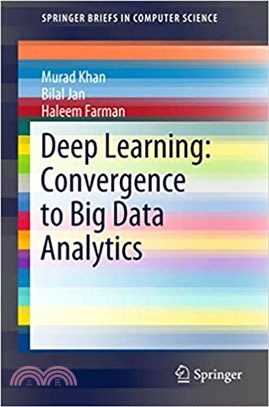Deep learningconvergence to big data analytics /
正題名/作者 : Deep learning/ by Murad Khan, Bilal Jan, Haleem Farman.
其他題名 : convergence to big data analytics /
作者 : Khan, Murad.
其他作者 : Jan, Bilal.
出版者 : Singapore :Springer Nature Singapore,2019.
面頁冊數 : xvi, 79 p. :ill., digital ;24 cm.
Contained By : Springer eBooks
標題 : Machine learning. -
電子資源 : 線上閱讀(Springer)
ISBN : 9789811334597$q(electronic bk.)
ISBN : 9789811334580$q(paper)
LEADER 02884cmm 2200229 a 450
001 300942
008 181230s2019 si s 0 eng d
020 $a9789811334597$q(electronic bk.)
020 $a9789811334580$q(paper)
035 $a00353255
041 0 $aeng
050 4$aQ325.5
082 04$a006.31$223
090 $aE-BOOK/006.31///UE035602
100 1 $aKhan, Murad.$3538283
245 10$aDeep learning$h[electronic resource] :$bconvergence to big data analytics /$cby Murad Khan, Bilal Jan, Haleem Farman.
260 $aSingapore :$bSpringer Nature Singapore,$c2019.
300 $axvi, 79 p. :$bill., digital ;$c24 cm.
490 1 $aSpringerBriefs in computer science,$x2191-5768
505 0 $aChapter 1. Introduction -- Chapter 2. Big Data Analytics -- Chapter 3. Deep Learning Methods and Applications -- Chapter 4. Integration of Big Data and Deep Learning -- Chapter 5. Future Aspects.
520 $aThis book presents deep learning techniques, concepts, and algorithms to classify and analyze big data. Further, it offers an introductory level understanding of the new programming languages and tools used to analyze big data in real-time, such as Hadoop, SPARK, and GRAPHX. Big data analytics using traditional techniques face various challenges, such as fast, accurate and efficient processing of big data in real-time. In addition, the Internet of Things is progressively increasing in various fields, like smart cities, smart homes, and e-health. As the enormous number of connected devices generate huge amounts of data every day, we need sophisticated algorithms to deal, organize, and classify this data in less processing time and space. Similarly, existing techniques and algorithms for deep learning in big data field have several advantages thanks to the two main branches of the deep learning, i.e. convolution and deep belief networks. This book offers insights into these techniques and applications based on these two types of deep learning. Further, it helps students, researchers, and newcomers understand big data analytics based on deep learning approaches. It also discusses various machine learning techniques in concatenation with the deep learning paradigm to support high-end data processing, data classifications, and real-time data processing issues. The classification and presentation are kept quite simple to help the readers and students grasp the basics concepts of various deep learning paradigms and frameworks. It mainly focuses on theory rather than the mathematical background of the deep learning concepts. The book consists of 5 chapters, beginning with an introductory explanation of big data and deep learning techniques, followed by integration of big data and deep learning techniques and lastly the future directions.
650 0$aMachine learning.$3169715
650 0$aBig data.$3366264
650 14$aDatabase Management.$3401899
650 24$aArtificial Intelligence.$3263467
650 24$aData Structures.$3407955
650 24$aBig Data.$3449531
700 1 $aJan, Bilal.$3538284
700 1 $aFarman, Haleem.$3538285
710 2 $aSpringerLink (Online service)$3374217
773 0 $tSpringer eBooks
830 0$aSpringerBriefs in computer science.$3407889
856 40$uhttps://erm.library.ntpu.edu.tw/login?url=https://doi.org/10.1007/978-981-13-3459-7$z線上閱讀(Springer)
950 $aComputer Science (Springer-11645)
Deep learningconvergence to big data analytics /[electronic resource] :by Murad Khan, Bilal Jan, Haleem Farman. - Singapore :Springer Nature Singapore,2019. - xvi, 79 p. :ill., digital ;24 cm. - SpringerBriefs in computer science,2191-5768. - SpringerBriefs in computer science..
Chapter 1. Introduction -- Chapter 2. Big Data Analytics -- Chapter 3. Deep Learning Methods and Applications -- Chapter 4. Integration of Big Data and Deep Learning -- Chapter 5. Future Aspects.
This book presents deep learning techniques, concepts, and algorithms to classify and analyze big data. Further, it offers an introductory level understanding of the new programming languages and tools used to analyze big data in real-time, such as Hadoop, SPARK, and GRAPHX. Big data analytics using traditional techniques face various challenges, such as fast, accurate and efficient processing of big data in real-time. In addition, the Internet of Things is progressively increasing in various fields, like smart cities, smart homes, and e-health. As the enormous number of connected devices generate huge amounts of data every day, we need sophisticated algorithms to deal, organize, and classify this data in less processing time and space. Similarly, existing techniques and algorithms for deep learning in big data field have several advantages thanks to the two main branches of the deep learning, i.e. convolution and deep belief networks. This book offers insights into these techniques and applications based on these two types of deep learning. Further, it helps students, researchers, and newcomers understand big data analytics based on deep learning approaches. It also discusses various machine learning techniques in concatenation with the deep learning paradigm to support high-end data processing, data classifications, and real-time data processing issues. The classification and presentation are kept quite simple to help the readers and students grasp the basics concepts of various deep learning paradigms and frameworks. It mainly focuses on theory rather than the mathematical background of the deep learning concepts. The book consists of 5 chapters, beginning with an introductory explanation of big data and deep learning techniques, followed by integration of big data and deep learning techniques and lastly the future directions.
ISBN: 9789811334597$q(electronic bk.)Subjects--Topical Terms:
169715
Machine learning.
LC Class. No.: Q325.5
Dewey Class. No.: 006.31
- 館藏(1)
- 心得(0)
- 標籤
- 相同喜好的讀者(0)
- 相關資料(0)

